Wykagyl Country Club
New Rochelle, New York
United States of America
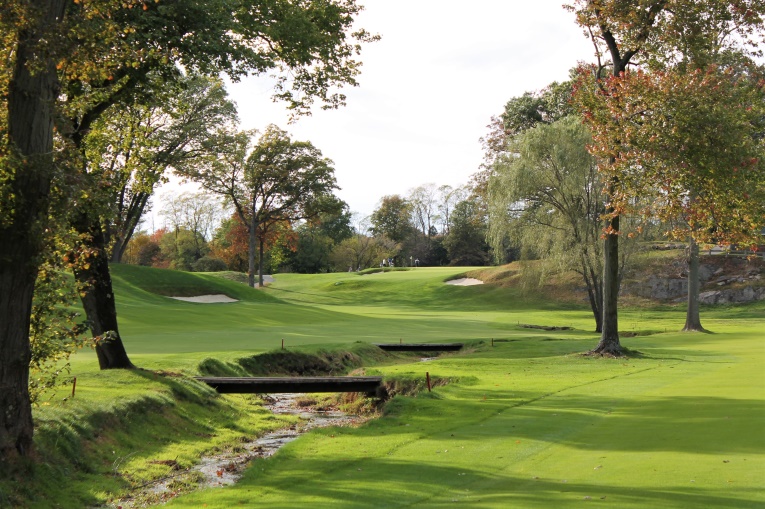
The more interesting the challenges, the more interesting the golf and Wykagyl’s intersecting valleys, jumbled land forms, creeks, and rock outcroppings lend this course as much appeal as any in golf-rich Westchester County.
The expression ‘too many chefs in the kitchen’ is one that applies all too frequently to golf design. Typically, the more people that work on a course, the more of a hodge-podge the design becomes with different styles competing for attention. Happily, Wykagyl Country Club is one of the rare exceptions. According to Bill Coore, it stands as a testament to positive evolution, one of the few he has ever encountered.
Let’s start at the beginning. The club was founded in Pelham in 1898 and moved five miles to today’s location in New Rochelle in 1905. Member Lawrence Van Etten designed the original 18 there. Though hardly the most prominent of the ten architects that eventually went on to work at Wykagyl, half of his playing corridors (1st, 2nd, 9th, 12th, 13th, 14th, 15th, 16th and 17th) are still in use, so give the man his due!
In 1919, Donald Ross added over 100 yards in length but more importantly, he constructed today’s wonderful (!) 3rd hole, significantly re-bunkered many holes, and introduced superior playing angles, especially at the modified 8th and 15th holes. Tillinghast visited during the early 1930s but to be clear, the Hell’s Half Acre at the 12th was Ross’s handiwork. While Ross became a prolific builder of courses in North Carolina and others parts of the northeast, he wasn’t as frequent a contributor to the landscape around New York City. How nice that Wykagyl enjoys Ross’s talents. Considering that his exalted status was not yet apparent in 1919, the club showed great foresight in hiring him.
As for Tillinghast, no one did better, more graceful work in the clay and granite around New York City than the ‘Warlock of Westchester.’ He added the superlative stretch of 4 through 6 on land that others had eschewed. Ross resisted dipping down and working in the lower area along the creek that now dominates play at the 5th and 6th. Indeed, Wykagyl’s club history makes reference to how those two holes were frequently out of play the two years immediately after their construction. Nonetheless, the club’s patience has paid off and with today’s drainage and agronomy, the pair sparkle.
Tillinghast disposed of the old 1st, 2nd and 10th holes and shortened the 18th by 165 yards when he turned it into a par 4. Essentially, he shifted play away from the clubhouse by creating more golf at the northeastern end of the property where additional interesting features were found to augment the offering. This had the tangential benefit of creating space for practice areas near the clubhouse, an amenity that became increasingly important to members as the last century wore on.
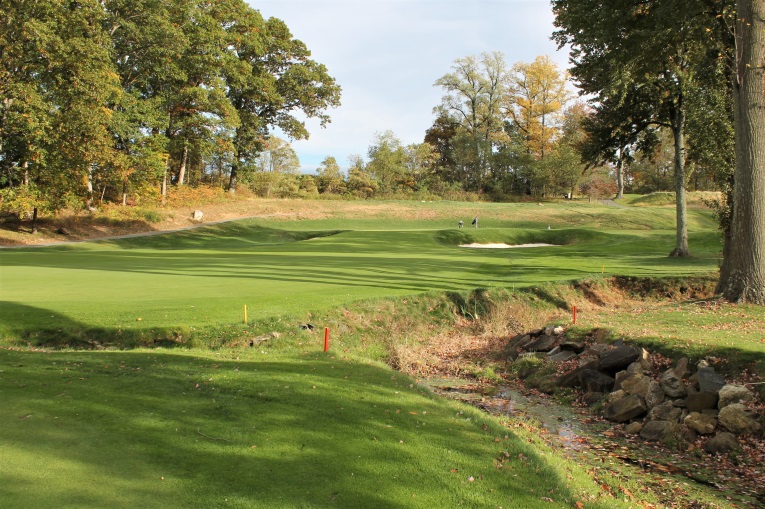
The game was played at Wykagyl for 25 years before Tillinghast brought golf to this portion of the property.
By 1940, the course stood essentially as it does today, a 6,600+ yard gem with spacious corridors between holes. Rightly so, the club enjoyed a fine reputation in the golf rich area and held various events over the next several decades. Of particular note was the Goodall Palm Beach Round Robin, named after the clothing line and won twice by Sam Snead and his ‘looser than cream corn’ swing. Other winners included Bobby Locke, Roberto de Vicenzo, and Gene Littler.
Of course, what also happened is that the trees continued to grow – and grow. At Wykagyl their impact was particularly harmful because they shrouded a superlative property where valley upon valley intersects. Throw in creeks, rock outcroppings and tumbling landforms and one’s heart breaks at the thought of masking such distinctive features. Inadvertent as it may have been but fostered because trees were very much in vogue during the four decades that closed out the last century, one of the most uncommon inland properties became badly compromised.
Move the storyline forward to 2003 when the club board was wrestling with drainage and a new irrigation system. There was also a general sense that the course wasn’t being presented to its fullest. As it so happened, Harrie Perkins, a friend of Bill Coore and Ben Crenshaw’s, was friendly with Martha Reddington, who sat on the Wykagyl Green Committee. Coore calls her ‘brilliant.’ In the publishing business, she played a central role in promoting and selling Harvey Penick’s The Little Red Book to golfers and the golf industry.
Harrie helped facilitate the introduction to Coore & Crenshaw and in Bill Coore, Wykagyl found a sympathetic listener. Why? While working for Pete Dye in the ’70s, Coore had been sent to assist Roy Dye with a potential project at Pound Ridge. That project never happened but some clearing occurred and the intricate permitting process kept Coore in the general area for three months. The Monday after the ‘Massacre at Winged Foot’, he played at Winged Foot with Tom McEvoy. A lasting friendship was struck and Coore was invited to play McEvoy’s other home course, Wykagyl, several times that summer. Coore’s general impression was that it was ‘quite interesting given the severity of the land movement.’
Guess who was the Green Chairman in 2003? Paul McEvoy, Tom’s nephew, who formally inquired that August if Coore & Crenshaw would be interested in looking at the project. McEvoy emphasized that a sizable amount of historical photographs and material was available for perusal. Famously persnickety for avoiding club politics, Coore & Crenshaw had in Martha Reddington and Paul McEvoy two primary club contacts with whom they knew they could work. Those two would interact with the members leaving Coore & Crenshaw to focus on the golf.
In March 2004, the club voted to pursue ‘a comprehensive restoration/renovation that materially improves the golf experience.’ Coore and James Duncan visited the property several times and Coore submitted a plan that winter to address the primary concerns. The board ultimately adopted it and work commenced in 2005. Duncan coordinated the project and Jeff Bradley and Jim Craig played their usual crucial roles. Fans of Coore & Crenshaw’s Hidden Creek in New Jersey (of which this author is emphatically one) will recognize all three names from that endeavor, which concluded in 2002.
As Coore puts it, ‘We felt that a lot of the lost character could be revitalized primarily by tree and bunker work.’ Nonetheless, he is quick to note that a big component of the project was out of sight, below ground. Getting drainage and irrigation right takes on particular importance when working in clay and rock. The luxury provided by sand didn’t exist.
All eighteen holes reopened for play in 2006, just over a century from the commencement of play at this location. That’s ten years ago before this writing and the author is boggled that this course isn’t better known. In the majority of states, it would surely be among the two or three best but in New York, it still flies under the radar. After seeing the mix of holes below, see if you aren’t equally dumbfounded!
Holes to Note
Third hole, 455 yards; As we shall discover, the composition of Wykagyl’s holes is unique and we begin by noting that there are ‘only’ eight par fours. This is the longest and it plays to a green that seems particularly ill-suited to accept a long approach! The tiger might reach the crest of the hill with his tee ball and enjoy some additional scoot forward, though he needs to weigh the advantage of having a shorter club versus contending with a downhill stance. Out of bounds crowds the left, likely making the approach the most nervy shot on the course. From a playability perspective, the hole highlights some of the less ‘sexier’ work done during the project, such as recapturing width in the fairway, expanding the green back to the edges of its pad, and improving drainage. As Coore puts it, ‘This hole lacked the dimensions to be compelling. Once the fairway crested the hill, it was a tiny sliver bordered on both sides by wet, thick rough. It was horribly penal for daily play. We were pleased to reintroduce width and dry it out while simultaneously expanding the putting surface’s front, rear and sides.’

At 4,870 square feet, the sharply canted third green is none too big a target, especially when you factor in the false front that comprises a chunk of the putting surface.
Fourth hole, 145 yards; Short but not necessarily sweet, the hole location creates the challenge. The lower right section is friendly enough with graceful bowl green contours that help balls collect there. When the hole location edges back and higher to the left, the going gets more dicey. Coore & Crenshaw spent a far amount of time massaging the tiny 900 sq. ft. back plateau so that it would function properly. When the club utilized it in the first round of the famed Ike Championship in 2013, the fourth played the most over par that day, a whopping 3.88. When the lower right location was employed two days later, the stroke average dropped to 3.09. A half shot change based on hole location is extremely high, so a .79 differential is astronomical!
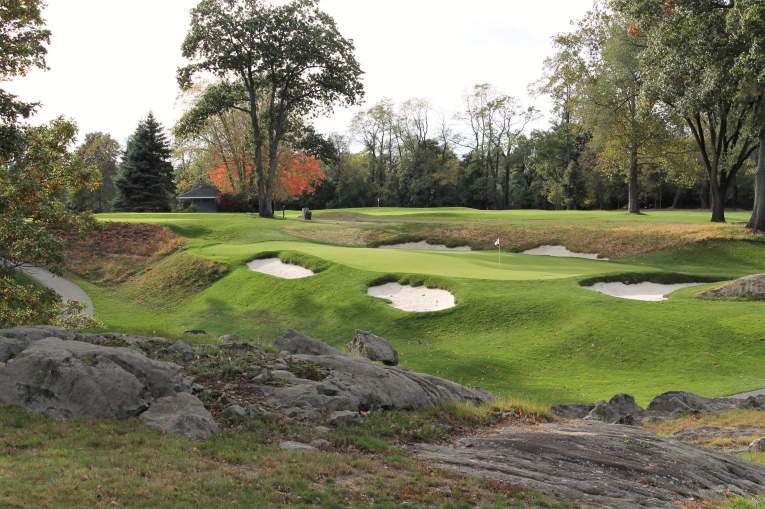
Today’s lower hole location with a ridge behind is user friendly, much more so than the evil back left plateau that can send even accomplished golfers into a tizzy.
Fifth hole, 395 yards; In general, parkland golf doesn’t enjoy the vagaries of weather or bouncy-bounce firm fescue playing surfaces to enliven play. Yet, a description of this hole – ‘tee off from a rock ledge to a fairway in a river valley and then cross a stream to approach an uphill green’ – conveys the joy that can be found inland on a well-routed hole that takes advantage of nature’s bounty.
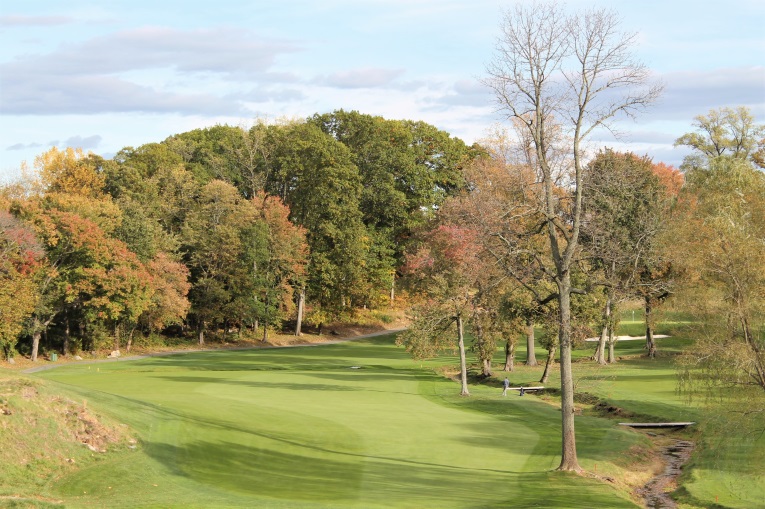
Coore & Crenshaw took great care to ensure that the flag could be gleaned through the trees. It acts as a siren, pulling the golfer farther right than is likely wise.
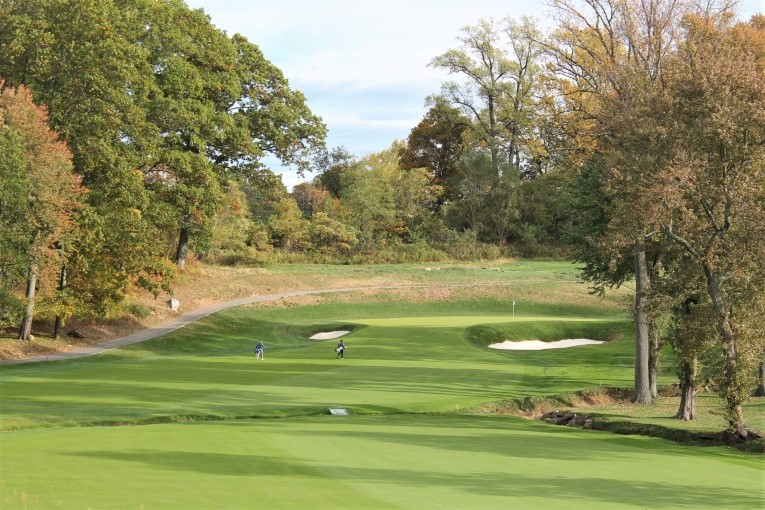
The native grasses have been cut back for the winter in this photograph but the green benched into the hillside is still an attractive target, best approached from the fairway’s left center.
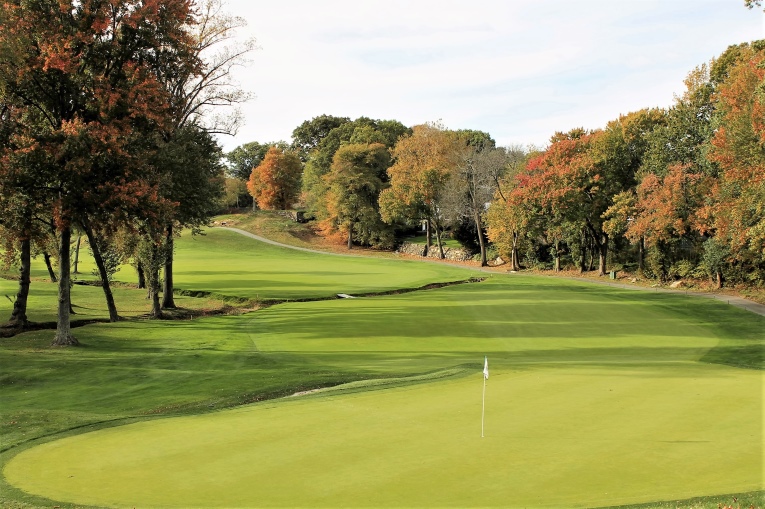
No surprise to learn that Ben Hogan – the all-time master of the power fade – was a huge fan of this hole.
Sixth hole, 525 yards; Beginning here one plays four five pars over the next seven holes and it is hard to imagine four more diverse holes of the same par. This is the longest of the bunch but is still reachable with two mighty blows. Once again, the golfer tees off from high and descends into the river valley where level lies are likely afforded. Then, does he have a crack at getting out of the valley and up onto the same level as the green or play within the valley, content with an uphill short iron approach for his third?
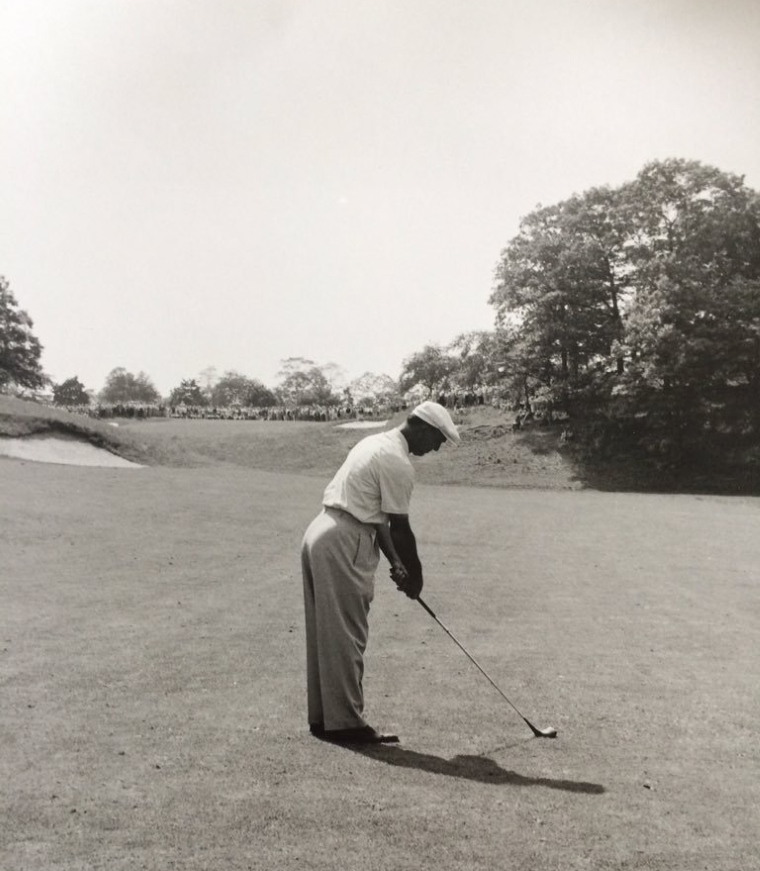
The man knew what he was doing. Note not only how he is in perfect position for having a go at the sixth green in two but how a sense of openness happily coexisted in the 1950s with specimen trees.
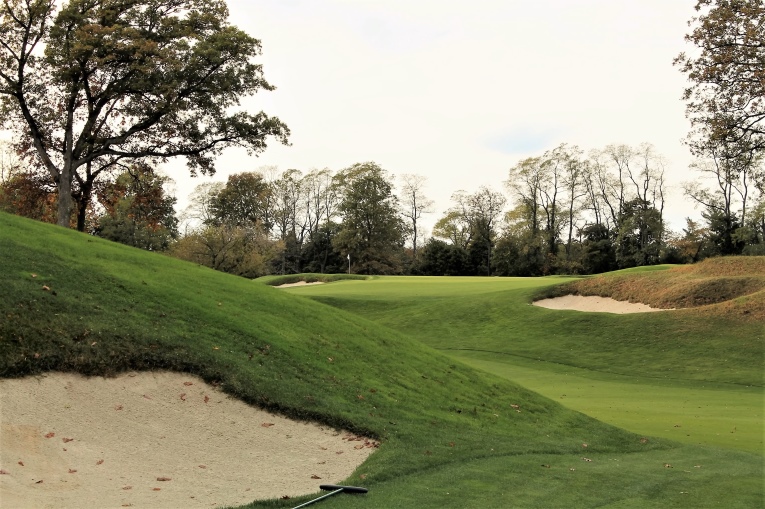
Fairways and landforms interact in every manner imaginable. At the sixth, it’s a twist through a valley before rising to the green.
Seventh hole, 170 yards; This original Van Etten hole plays across a valley to a green benched into the far hillside. As green speeds increased, so did the hole’s infamy as it enjoyed more back to front cant than any green on the course. In recent times though, the green had become a caricature of itself with only three viable hole locations. Coore & Crenshaw worked as hard on this green as any to a point where some members voiced concern that its character might be too muted. Coore smiles because this remains the single toughest green on which to consistently get down in two putts.
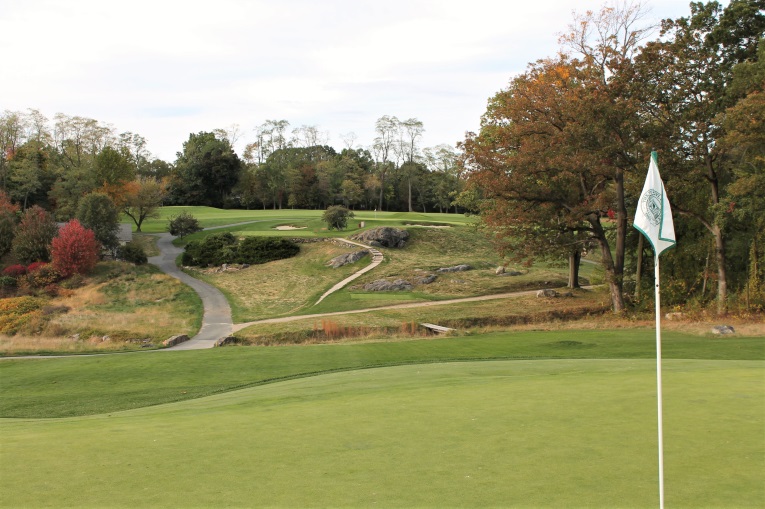
After playing this par 3 in 1905, Van Etten had the golfer play another one shotter toward the red tree in the distance.
Eighth hole, 445 yards; As was common in the early 1900s when Van Etten built the course, the playing corridors were mostly straight with a only few that featured attractive bends. By today’s standards, Van Etten’s design was deficient of playing angles, save for today’s fourteenth. Ross’s bunkers and Tillinghast’s work and the fine-tuning by Coore & Crenshaw corrected that. Holes five, six, fifteen and this one provide testimony. Ross abolished Van Etten’s consecutive par 3’s in favor of this superb dogleg left. It is a contender for the best hole on the course and is certainly among the very best in Westchester.

The bold line off the tee splits the two bunkers and the golfer is rewarded with a big forward kick off the far shoulder.
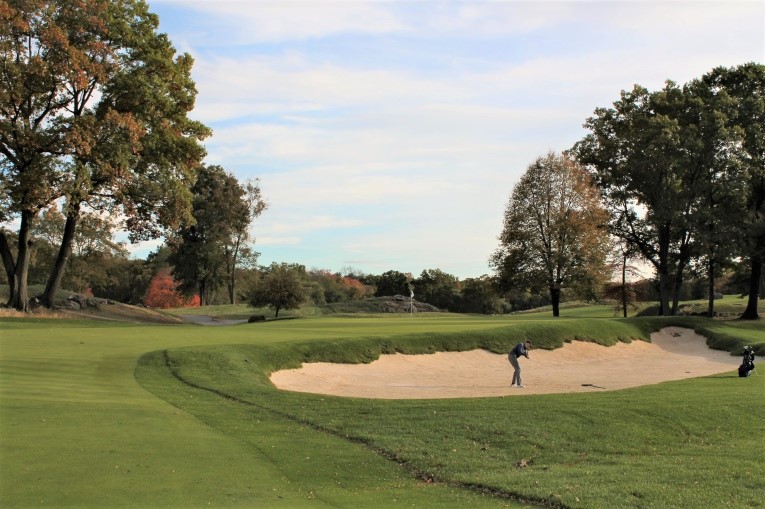
The largest greenside bunker on the course dominates the green’s right side and places emphasis on finding the left center of the fairway off the tee.

Playing the Palm Beach routing has golfers go from the 8th green to the 12th tee seen above. The sequence becomes 8,12-18,10,11,9 which makes for a 5-3-5 finish where anything can happen.
Ninth hole, 495 yards; The most unusual aspect of Van Etten’s remaining work is embodied here. Fans of the Home hole at Yale Golf Club will appreciate Van Etten’s gumption in his take-no-prisoners approach of having this fairway scale a small mountain. He did something similarly at the last which prompted Harry Vardon to remark, ‘It is only by remembering that the clubhouse is at the top of this mountain that the portly Member even summons up courage to attempt the ascent.’ While Ross left the Home hole intact, Tillinghast did not but both men were thankfully content to leave the 9th as Van Etten routed it.

The ideal drive finishes in the flat near the top left man. From there, the golfer has a reasonable chance to crest the hill with his second and chase a shot onto …
Tenth hole, 515 yards; How holes interact with those around them offers a good barometer of a course’s variety. At the three-shot tenth, the approach is uphill to a three-tiered putting surface that is generally out of view. The next is a one-shotter, steeply downhill and everything is apparent while standing on the tee. Even more impressive is the juxtaposition of the 9th and 10th holes. The former features a flattish green well below the fairway while the latter possesses one of the course’s most severe greens situated well above the golfer. So it goes, throughout the round there are ever-shifting challenges. At the end, an inescapable conclusion is reached that everything has been asked of the golfer in a most delightful manner.
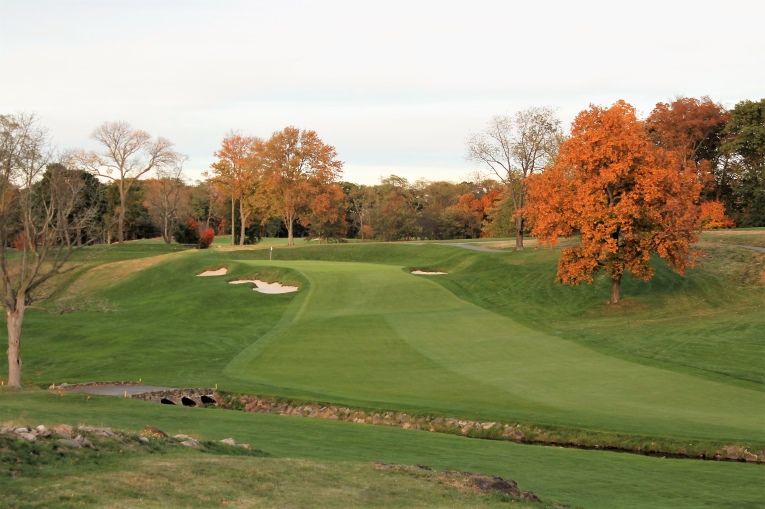
The course’s deepest greenside bunker and three-tiered green give the golfer pause from wildly slashing at the 10th in two.
Twelfth hole, 500 yards; Laid across a high section of the property, the 12th fairway actually enjoys the best micro undulations courtesy of boulders buried beneath. The course’s largest hazard pares the fairway width in half at the hitting zone and does what it should: make some members sob with regret, which is another way of saying that it is well-placed! Combined with the knob green perched at the edge of a ravine, the thinking golfer has to consider if a driver is the prudent play. It is a marvelous case study of how a spacious hole remains tactical.
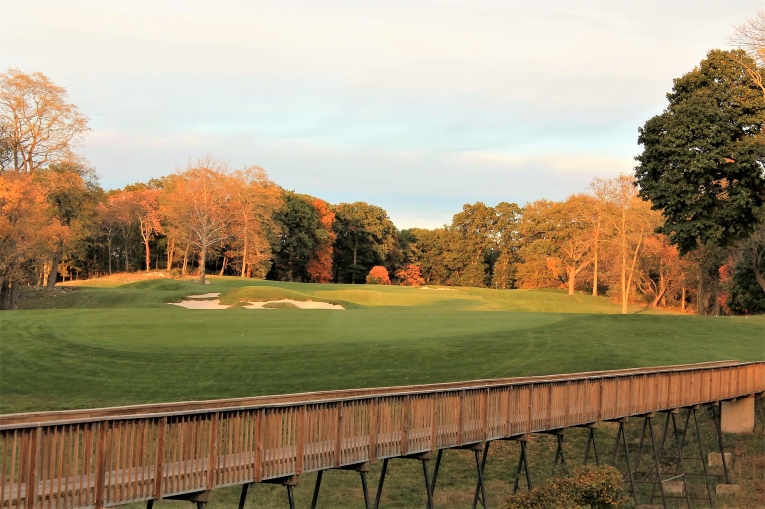
Given all the valleys, one might think the course had more elevated bridges but this is the only one.

Ross’s massive central bunker was reintroduced as part of the Coore & Crenshaw restoration. It isn’t the only thing hazardous in the fairway …
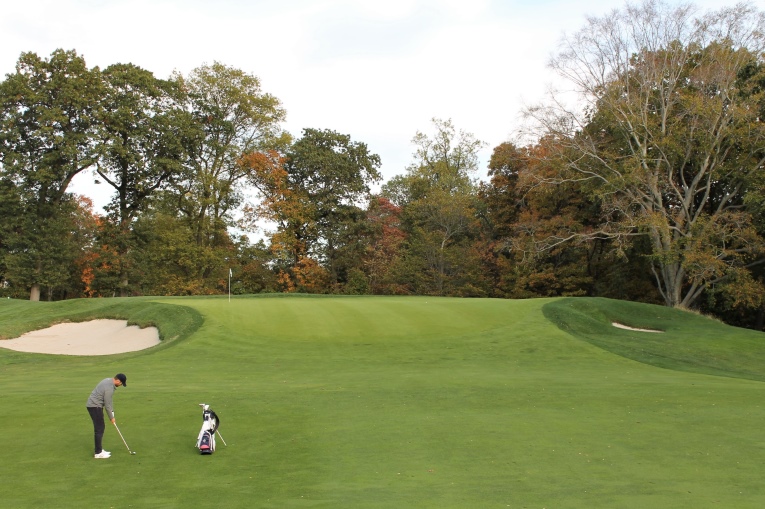
The course’s most severe false front makes the pitch to the 12th anything but straightforward. Behind the green is a ravine and even more nerves would be frayed if its presence was felt more.
Thirteenth hole, 210 yards; One-shotters are a particularly effective design tool for getting a golfer from one side of a valley to the other. Three of Wykagyl’s five one-shotters (four, seven and here) do just that with this being the most dramatic. Similar to the 7th, the green features a sharp back to front tilt. At tournament speeds, Green Keeper Dan Rogers is loath to use the front two thirds (!) of the green as balls can roll from the green’s middle thirty yards off. More than wicked interior contours, the greens at Wykagyl challenge via pitch and cant. In general, the eye can determine the proper play from well back by studying the green surrounds. Some modern architects get too fanciful with multi-tiered greens whose movements are detached from their surrounds and the game devolves into one of hit and hope. Not at Wykagyl.
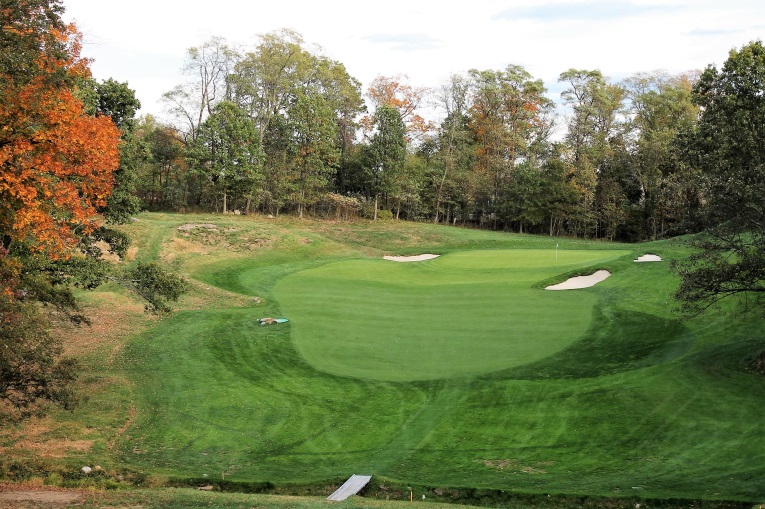
This green follows the slope of the land and tee balls that aren’t fifteen paces into the twenty eight yard deep green can be funneled down and off.
Fourteenth hole, 400 yards; Van Etten’s feel for the land was exemplary and is seen throughout many of his remaining holes (and even his defunct par 5 18th). Here, he pointed the tees toward the perimeter and turned the fairway to run alongside. By so doing, he captured a ‘saddle’ in the fairway that subtlety but substantially impacts play. That’s what talented architects do – find minute features and embed them into play. This hole is another reminder of how fortunate the original members were that he laid out their course.

The tiger tries to carry the last bunker on the right. If successful, he is granted a view of the flag and maybe the green. A more cautious line off the tee leaves the golfer low in a saddle with less encouraging prospects.
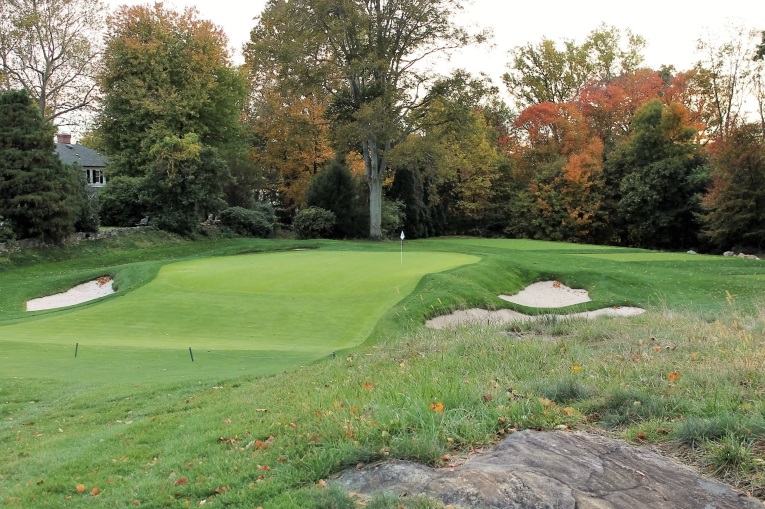
Another false front puts strain on the nerves as does a central ‘puff’ that Coore floated into the green. This green joins 4, 7, and 18 for having received the most attention from Coore & Crenshaw.

Coore & Crenshaw’s deep bunkers cut into the green’s base are better aligned to the green than their predecessors.
Fifteenth hole, 340 yards; Managing greed is central to a successful round at Wykagyl. In 1998 this hole was 362 yards on a course that measured 6,702 yards. Today, the layout is just under 6,700 yards, largely, because the club board was shrewd enough to agree with Coore & Crenshaw’s plan to shorten this hole by 20 yards. Sadly, not many architects and not many clubs are savvy enough to subtract length in this age. As Coore notes, ‘The hole that we encountered was one that required two completely defensive shots, one from the tee and one to the green. Trees hung over the left and acted to steer the golfer toward safety. We thought the hole would be better presented if it was allowed to lure the player into more trouble by enticing him to drive on or close to the green. Hence, we thought the reduced length would add character.’ Coore & Crenshaw changed this hole more than any other on the course, taking it from one of the three or four worst to one of the three or four best. Indeed, some folks compare it favorably to Tillinghast’s famed little beauty, fifteen at nearby Fenway Country Club.
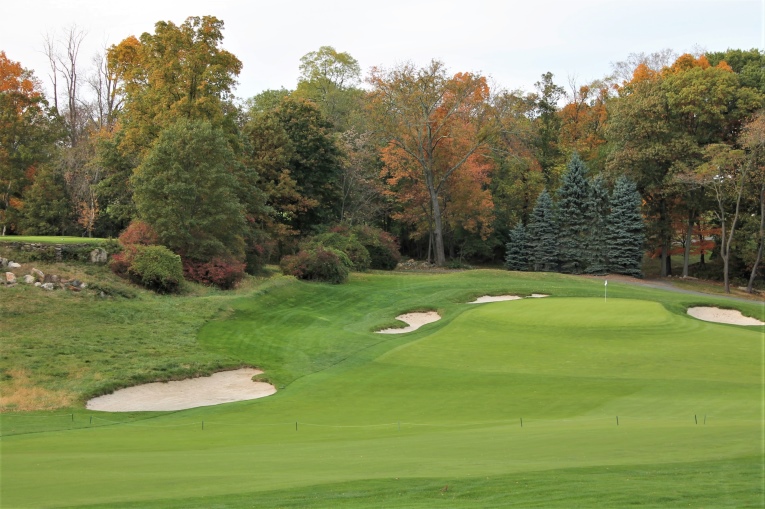
The green’s false front and false side make the sight of a right front hole location one of dread. Today’s one on the ever narrowing back plateau isn’t comforting either.

A pull or hook with a driver is an unwanted outcome. Like all top notch architecture, the golfer is now wooed on the 15th into bad decisions despite the copious amount of room provided to play prudently. It’s Coore & Crenshaw at their irritating best.
Sixteenth hole, 225 yards; A muscular hole with everything laid before the golfer but none the easier for it. A rock ledge provides clear optics to the green at the base of a second outcropping. Sixteen begs the golfer to manufacture some sort of low running shot as the fairway gradually and seamlessly turns into a putting surface, where puffs, bowls and plateaus await. These features rather than length made it play the hardest hole in relation to par during the 2013 Ike Championship.
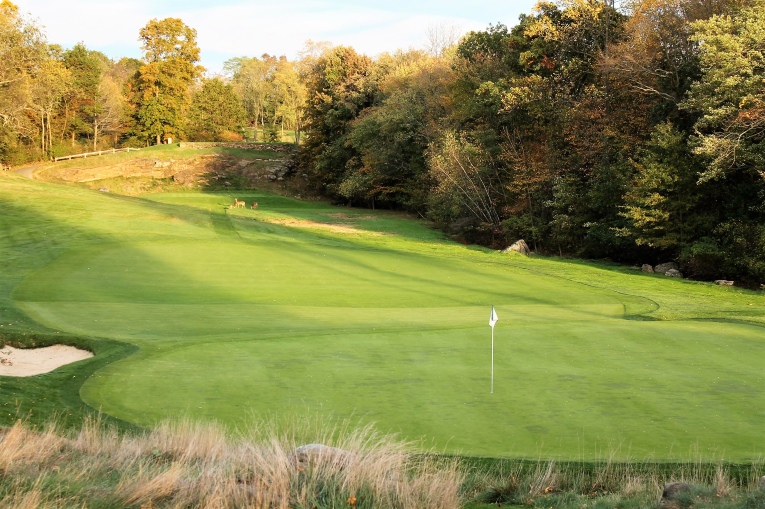
Looking back toward the elevated tee, the long sixteenth is one of the most interesting shots to watch play out …
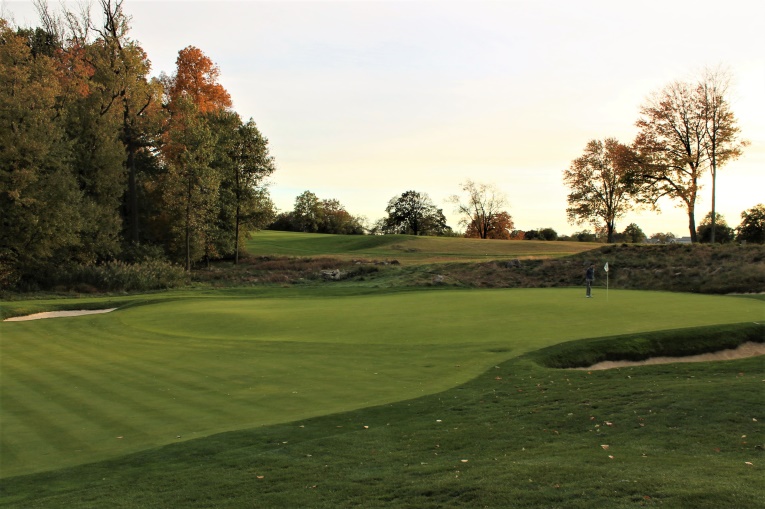
… along the ground. Talk about a great course to be a member – every green save for the 18th is open in front. Golfers can learn the game as well as finish playing here with equal delight.
Seventeenth hole, 355 yards; Just when you think you might have seen it all comes the course’s other most unique hole. Like the 9th, the author is quite taken by how two unconventional holes come late on each side. Both provide a sense of the rambunctious land and offer something more interesting than a straightforward, text book examination (yawn). Tillinghast moved Van Etten’s green some 60 yards left and snuggled it against the property’s boundary. A perfectly executed bullet draw turns the corner and scampers downhill as much as 60 (!) yards. Accomplished players seek a spot ~70 yards short left of the green from where they are afforded a reasonably level stance. Any course with five reachable par fives favors the golfer who can move his tee ball. At Wykagyl the man that can construct the perfect tee ball is amply rewarded but here it is because he is crafty rather than prodigiously long.

… plunging left and carreening downhill to a green 40 feet below. Coore & Crenshaw reconfigured the deep greenside bunkers so that the none-too-big 17th green is a surprisingly elusive target for a hole of such modest length.
The Home hole is nobody’s favorite on the course. Featuring a level fairway between two water hazards and a daunting uphill approach that requires perfection, the hole isn’t in keeping with the attributes spread across the other seventeen holes. Less than 3,500 sq. ft. in size, the target is not only the smallest on the course but it is the only one that doesn’t offer ground access. While the out-of-character nature of the Home is regrettable, most matches end before the final hole anyway. Indeed, the disproportionate emphasis placed by some Americans on the Home hole is not something to which the author subscribes.
Coore & Crenshaw’s work lends the course continuity with a single voice that any course would benefit from. Though many other architects worked here, notably Robert White who deserves credit for the location of the 8th and 12th greens in the 1920s, it is Van Etten’s backbone and Ross and Tillinghast’s modifications that give the course its flavor. Its overall design appears Golden Age without reminding one of a particular architect. And that’s very neat.
For Coore’s part, the only course with valleys that flow in and out of one another in a remotely similar fashion is the West Course at Yokohama in Japan. As for the design, Coore thinks it enjoys hints of Perry Maxwell’s Old Town in Winston Salem. Coore sums up Wykagyl as follows, ‘A great routing has emerged over time with holes weaving over hills, through valleys, and across creeks. How they got all the holes in there is amazing and it is one of the most interesting designs I have ever seen on severe property. When I think of Wykagyl, the word ‘interesting’ always springs to mind – interesting land, interesting hazards and interesting holes. It is easy to make a course hard; it is a far greater challenge to make a course interesting and that’s what they have done at Wykagyl.’




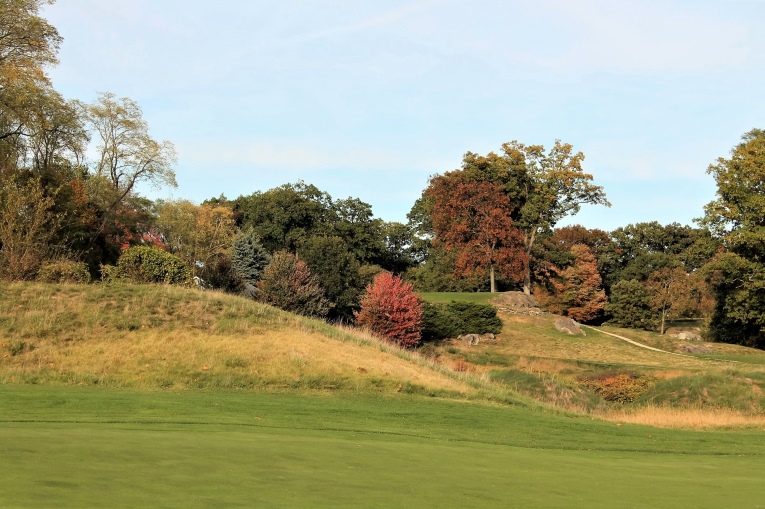

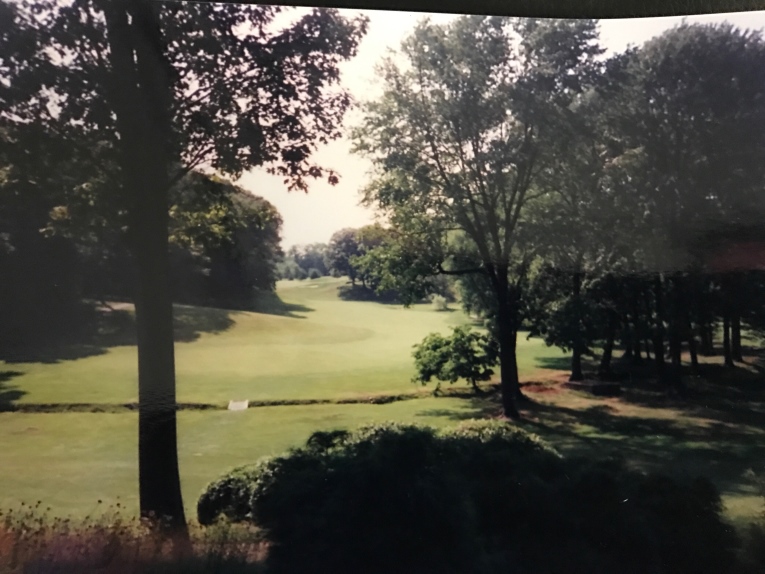
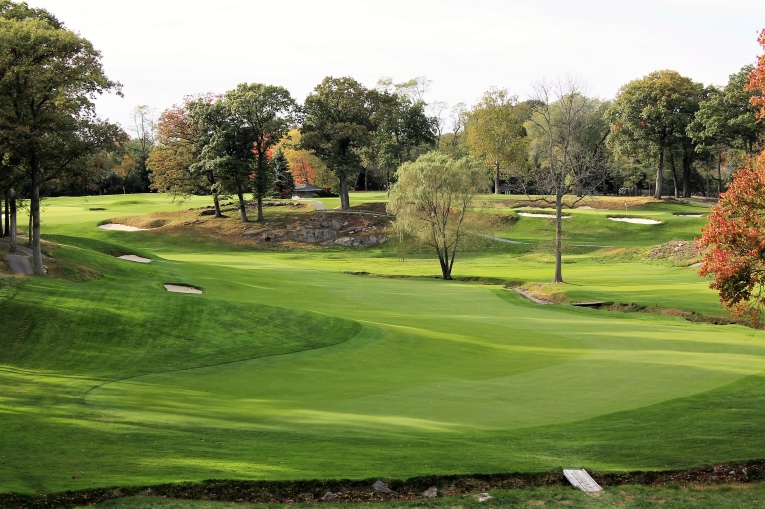
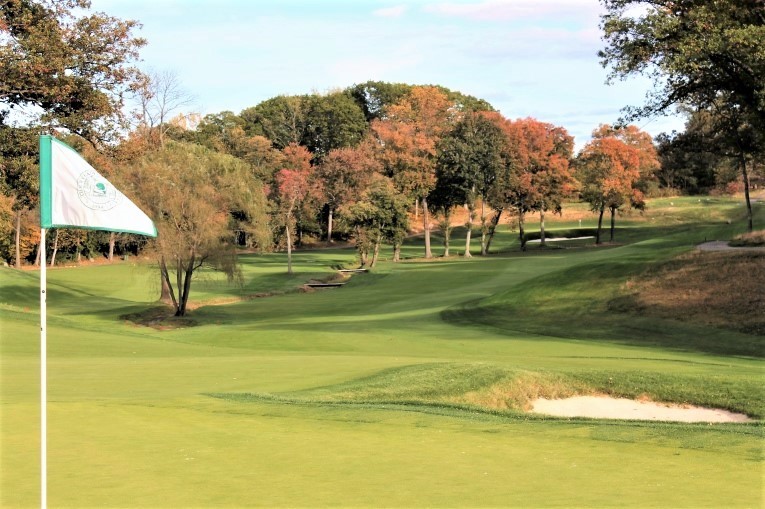


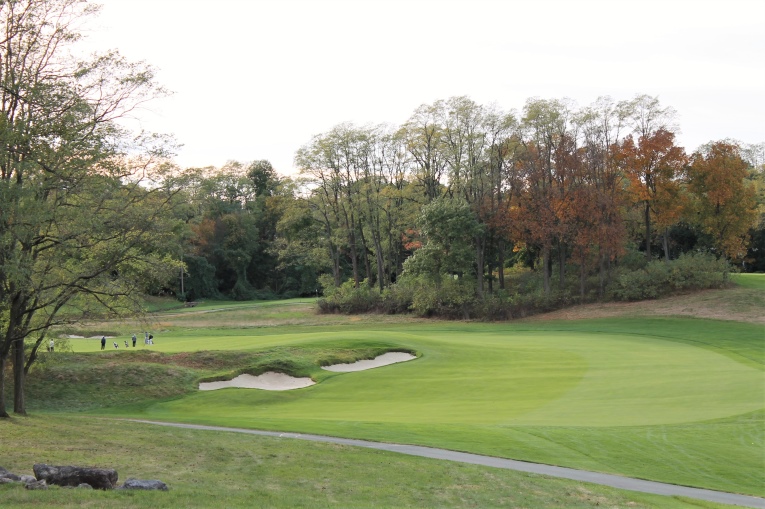
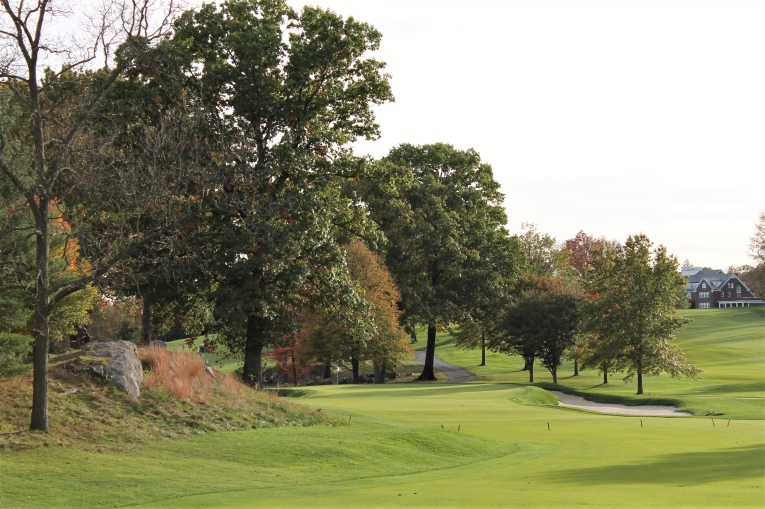
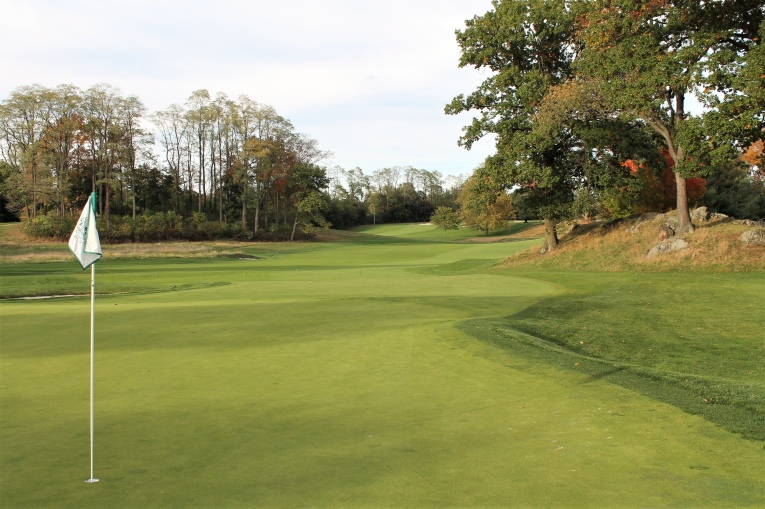
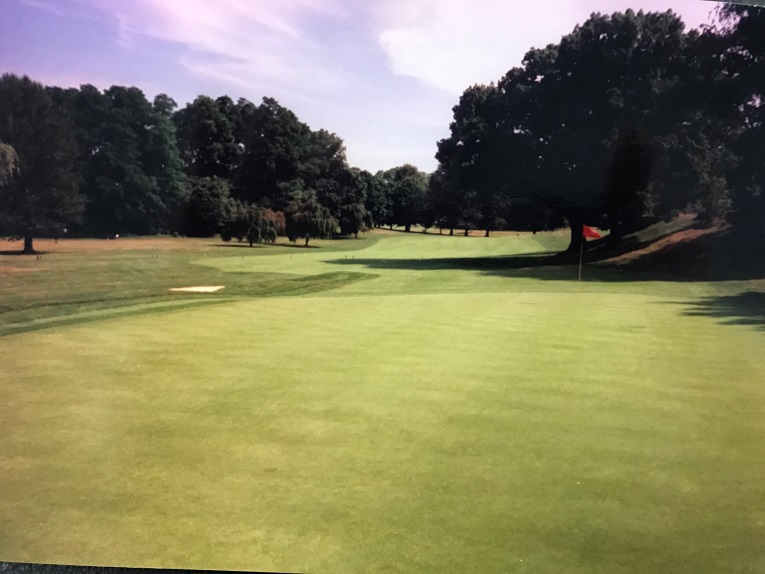

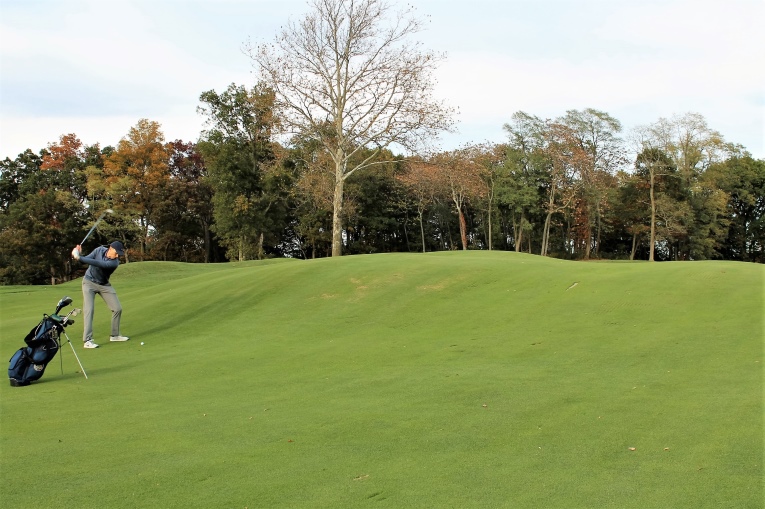


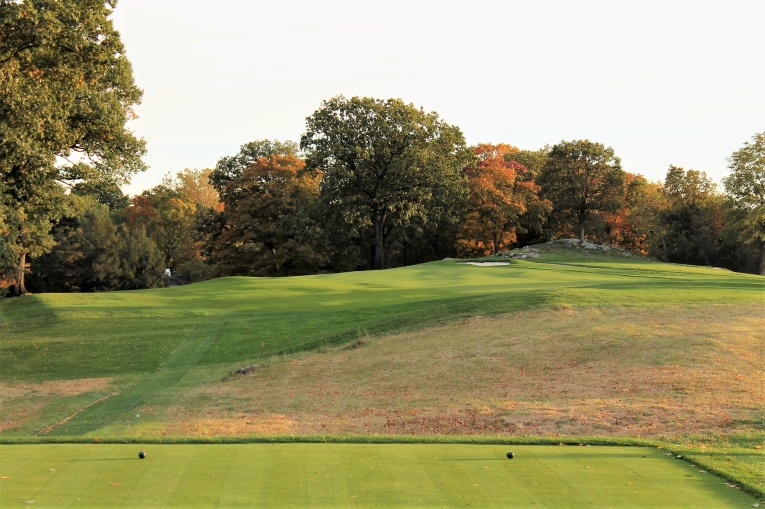



![The Park, West Palm (Lit 9) [2023]](https://golfclubatlas.com/wp-content/uploads/2024/12/IMG_7092-2-scaled-500x383.jpg)


